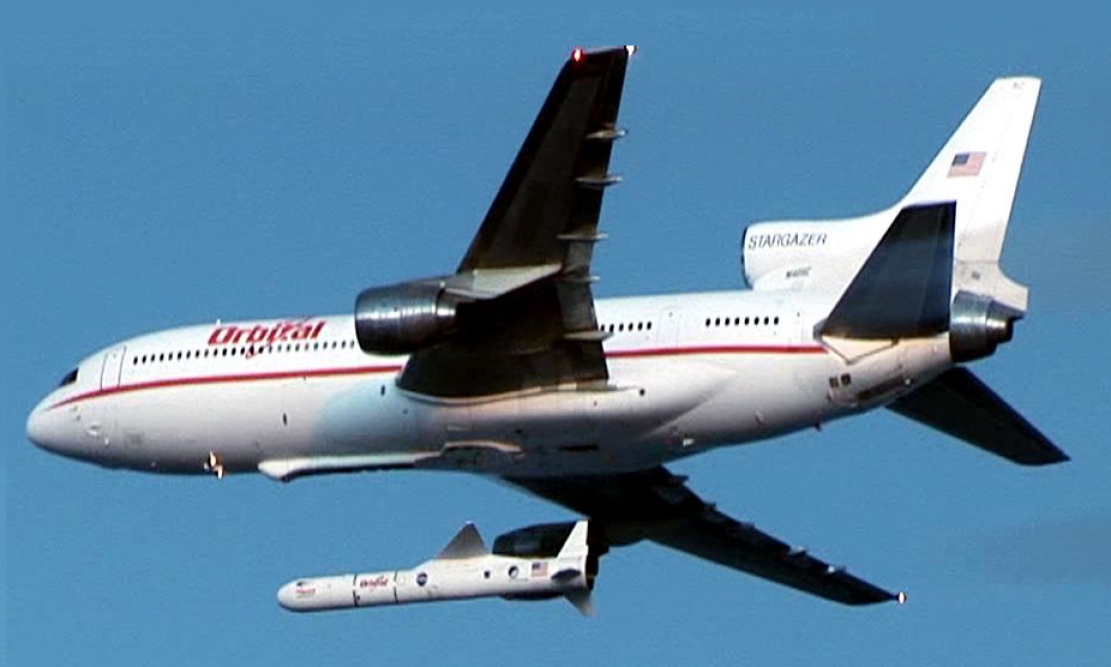
Pegasus
In-activeOrbital Sciences Corporation (OSC)
April 5, 1990
Description
The Pegasus is an air-launched rocket developed by Orbital Sciences Corporation (now part of Northrop Grumman Innovation Systems). Capable of carrying small payloads of up to 443 kilograms (977 lb) into low Earth orbit, the vehicle consists of three solid propellant stages and an optional monopropellant fourth stage. Pegasus is released from its carrier aircraft at approximately 40,000 ft (12,000 m), and its first stage has a wing and a tail to provide lift and attitude control while in the atmosphere.
Specifications
-
Stages
3 -
Length
16.9 m -
Diameter
1.27 m -
Fairing Diameter
― -
Launch Mass
18.0 T -
Thrust
580.0 kN -
Apogee (Sub-Orbital)
4000.0 km
Family
-
Name
Pegasus -
Family
― -
Variant
― -
Alias
― -
Full Name
Pegasus
Payload Capacity
-
Launch Cost
$40000000 -
Low Earth Orbit
443.0 kg -
Geostationary Transfer
Orbit
― -
Direct Geostationary
― -
Sun-Synchronous Capacity
―
Orbital Sciences Corporation
Commercial
None
OSCPegasus | APEX
Orbital Sciences Corporation | United States of AmericaAir launch to orbit
Aug. 3, 1994, 2:38 p.m.
Status: Launch Successful
Mission:
APEX (Advanced Photovoltaic & Electronic Experiment) successfully tested a wide array of advanced photovoltaic and electronic components in a harsh radiation environment, provided significant data to support improved designs for future space systems. During operation, APEX's highly elliptical orbit allowed the investigation of space plasma effects on high-voltage operation (current leakage at positive voltages and arcing at negative voltages) in the perigee region, plus the investigation of space radiation effects (decreased array power output from passage through the inner radiation belt) in the apogee region.
Elliptical OrbitPegasus | Array of Low Energy X-ray Imaging Sensors (ALEXIS)
Orbital Sciences Corporation | United States of AmericaAir launch to orbit
April 25, 1993, 1:56 p.m.
Pegasus | Satélite de Coleta de Dados-1 (SCD-1)
Orbital Sciences Corporation | United States of AmericaAir launch to orbit
Feb. 9, 1993, 2:30 p.m.
Falcon 9
Starlink Group 11-15
Space Launch Complex 4E - Vandenberg SFB, CA, USAA batch of 28 satellites for the Starlink mega-constellation - SpaceX's project for space-based Internet communication system.
Long March 8A
SatNet LEO Group 14
Commercial LC-1 - Wenchang Space Launch Site, People's Republic of ChinaA batch of 9 Low Earth Orbit communication satellites for the Chinese state owned SatNet constellation operated by the China Satellite Network Group.…
Kuaizhou-1A
Traffic VDES A & B
Launch Area 95A - Jiuquan Satellite Launch Center, People's Republic of ChinaTwo technology demonstration satellites for satellite transmissions of signals for the VHF Data Exchange System (VDES), a successor to the current Au…
Falcon 9
Starlink Group 11-25
Space Launch Complex 4E - Vandenberg SFB, CA, USAA batch of 28 satellites for the Starlink mega-constellation - SpaceX's project for space-based Internet communication system.
Zhuque-3
Demo Flight
Launch Area 96B - Jiuquan Satellite Launch Center, People's Republic of ChinaFirst test launch of LandSpace’s ZQ-3 rocket, with a dummy payload. The rocket’s 1st stage will attempt to land on a landing pad about 300 km downran…

